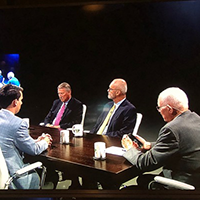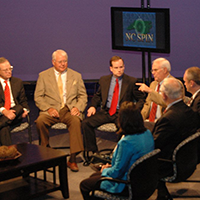Clinton-Trump in virtual tie in NC
Published October 7, 2016
by Matthew Burns, WRAL, October 4, 2016.
Five weeks from the Nov. 8 election, North Carolina remains a toss-up in the presidential race, according to a WRAL News poll released Tuesday.
Democrat Hillary Clinton edges Republic Donald Trump 46 to 44 percent, well within the margin of error of +/- 3.9 percentage points in the Survey USA poll. The firm contacted 656 likely voters statewide between last Thursday and Monday to compile its results.
Libertarian Gary Johnson was at 5 percent support in the poll, and 6 percent of voters remain undecided.
Clinton, Trump and their surrogates have been crisscrossing North Carolina for weeks, trying to shore up support and pull as many of the undecided voters into their respective camps. First lady Michelle Obama was in Raleigh and Charlotte on Tuesday to build support for Clinton among younger voters.
Clinton already has a 14-point lead over Trump among voters ages 18 to 34, according to the poll, while Trump has a 12-point lead among those 35 to 49. Clinton has a slight 5-point lead among voters 50 and older.
The presidential race also breaks along racial, gender and socio-economic lines, the poll results show.
Trump has clear advantages with whites and men, while Clinton is overwhelmingly favored by black voters and has a solid lead among women. Voters with at least a college degree back Clinton 57 to 34 percent, while those with only a high school diploma or some college education break for Trump by 10 to 18 points.
Clinton leads Trump 64 to 27 percent among urban voters and holds a 9-point edge in the suburbs, but rural voters support Trump by a 53 to 35 percent margin. Trump also holds a slight edge among voters earning $40,000 or more a year, while Clinton has a 17-point lead among people making less than that.
The economy and national security are far and away the top concerns among voters, with 59 percent of respondents calling one or the other the top issue facing the U.S. Immigration and health care tied for third at 11 percent each.
Trump, whose signature campaign themes have been building a wall along the Mexican border and stricter screening of immigrants to reduce the chances of foreign terrorists getting to the U.S., scores high among voters who are most concerned with national security and illegal immigration. He had a 20-point lead among those who ranked national security as the most pressing issue facing the country, and more than three-quarters of those who ranked immigration as their top concern back Trump.
Meanwhile, Clinton has an 8-point lead among those voters most concerned about the economy a 39-point lead among those who say health care is the biggest national issue.
October 7, 2016 at 10:43 am
Richard L Bunce says:
Digging into this poll here is description of methodology. No mention of not response rate. No mention of actual adjustment of raw data, just possible adjustments in the most generic language. No mention of how likely voter was determined. This poll provides data... just not viable data.
"Statement of Methodology: SurveyUSA is an independent, non-partisan, apolitical research company that conducts opinion surveys for media, academic institutions, commercial clients, non-profits, governments, agencies and elected officials. SurveyUSA opinion research is conducted using a methodology optimized for each particular project. In some cases, this means data is
approximately 30% of calls to home phones, the youngest adult is requested on approximately 70% of calls. This method of intra-household selection reduces the potential for age and gender imbalance in the unweighted sample. Re-attempts are made to busy signals, no-answers and answering machines. For surveys using random-digit-dial (RDD) to call landline phones, sample is
of respondents who use a home phone and the percentage who do not, and crosstabs by this distinction. If sample of adults is drawn from SSI, responses are minimally weighted to U.S. Census targets for gender, age and race. If sample of voters is drawn from Aristotle, responses are minimally weighted to the known demographics of the voter file, which include gender and age but,
typically, not race. Target (cell) weighting is used. On questionnaires that ask about political party identification, SurveyUSA may or may not weight to Party ID, depending on client preference. Where necessary, questions and answer choices are rotated to prevent order bias, recency and latency effects. On some studies, certain populations are over-sampled, so that the number of
unweighted respondents exceeds the number of weighted respondents. Each individual SurveyUSA release contains the date(s) on which interviews are conducted and a release date. If interviewing for a particular study is conducted in Spanish, or in any other foreign language, it will be noted on the specific release. If no notation appears, interviews are conducted in English.
Where respondents are filtered, such as adults, filtered to registered voters, in turn filtered to likely voters, SurveyUSA describes the filtering on the specific release. On pre-election polls in geographies with early voting, SurveyUSA differentiates between respondents who have already voted and those who are likely to vote but have not yet done so. SurveyUSA assigns to each







